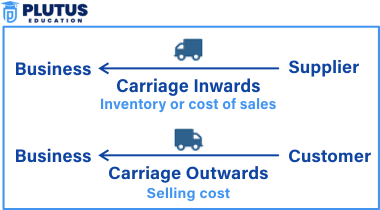In accounting, carriage outwards is said to be the expenses a firm incurs when shipping or delivering commodities to the buyers. These costs are one of the most significant constituents of distribution costs and will be usually presented separately from other freight or transportation expenses that relate to procurement costs, such as carriage inwards. We will discuss in this paper what carriage outwards is, how it is treated in an accounting record, and the difference between carriage outwards and carriage inwards.
Carriage Outwards Meaning
Carriage outwards is the shipping costs incurred by a business in transporting their finished goods to customers. These costs are incurred when an organization incurs expenditures by shipping goods to the customer, which may involve shipping costs, handling charges, and delivery fees. The cost is borne by the seller and forms part of the general selling expenses, which is crucial to the businesses that deliver products to clients directly.
For example, if a manufacturer sells some goods and makes arrangements for delivery to the buyer’s location, the expenses for such delivery are regarded as carriage outwards. Such expenses are not included in the cost of goods sold but are included as part of selling expenses separately.
Carriage Outwards: Is It Debit or Credit?
Carriage outwards is a debit entry in financial accounts when taking it. This, being an expense incurred by the business, increases the company’s total expenses, thereby decreasing its net profit. In a journal entry, you debit the carriage outwards account and credit either the cash or bank account depending on your mode of payment.
Example of a journal entry:
- Debit: Carriage Outwards Account
- Credit: Cash/Bank Account
The debiting of carriage outwards reflects that this cost decreases the company’s earnings. Hence, it’s categorized under selling expenses.

Carriage Outwards in Trial Balance
On the trial balance, carriage outwards shall appear as a debit item since it is passed under the head of expense account. They fall under the “expenses” section, normally at the selling and distribution expenses. Its existence on the trial balance facilitates checking that all transactions have been recorded appropriately so that the debits agree with the credits.
In other words, carriage outwards affects the profitability of the company because it directly decreases the operating profit brought out in the income statement.
| Trial Balance | Debit | Credit |
|---|---|---|
| Carriage Outwards | XXX |
Carriage Outwards in Trading Account
Unlike cost of goods sold expenses, carriage outwards goes to the profit and loss account and is not included in the trading account because it deals with supplying and selling commodities and, hence, should not be included in the production or purchase of commodities.
This accounting expense is also accounted for after showing the gross profit of the company, and while subtracting the cost of goods sold from the sales revenue in the trading account, carriage outwards adjustment is subtracted later when getting to the final net profit computation in the financial statement.
Carriage Outwards in Final Accounts
Carriage outwards is disclosed in the profit and loss account in the final accounts, under selling and distribution expenses. Final accounts give a generalized view of the profitability condition of the company, and carriage outwards play a vital role in determining the net profit fairly.
Here’s how it appears:
Profit and Loss Account:
- Gross Profit (as calculated in the trading account)
- Less: Selling and Distribution Expenses (including carriage outwards)
Example:
| Profit and Loss Account | Amount |
|---|---|
| Gross Profit | 10,000 |
| Less: Carriage Outwards | 2,000 |
| Net Profit | 8,000 |
Difference Between Carriage Outwards and Carriage Inwards
Understanding the difference between carriage outwards and carriage inwards is crucial as they affect different parts of the financial statement.
| Basis | Carriage Outwards | Carriage Inwards |
|---|---|---|
| Definition | Cost of delivering goods to customers | Cost of bringing goods into the business |
| Account Treatment | Recorded as a selling expense in the P&L account | Added to the cost of purchases or inventory cost |
| Impact | Reduces net profit | Increases cost of goods sold (COGS) |
| Shown in | Profit and Loss Account | Trading Account |
Now, carriage outwards is a selling cost. On the other hand, carriage inwards is a component of the cost of production or procurement of goods. Thus, carriage inwards will be included when calculating gross profit, but it has no role to play when computing net profit.
Carriage Outwards FAQs
Is carriage outwards a direct or indirect expense?
Carriage outwards is considered an indirect expense because it is not directly related to the production or procurement of goods but is associated with the delivery and distribution of products to customers.
Is carriage outwards included in the trading account?
No, carriage outwards is not included in the trading account. It is recorded in the profit and loss account under selling and distribution expenses.
How is carriage outwards recorded in the trial balance?
In the trial balance, carriage outwards is recorded as a debit item because it is an expense incurred by the business.
What is the difference between carriage inwards and carriage outwards?
The main difference is that carriage inwards refers to the cost of transporting goods into the business, while carriage outwards is the cost of delivering goods to customers. Carriage inwards is included in the cost of goods sold, whereas carriage outwards is a selling expense.
Does carriage outwards reduce net profit?
Yes, carriage outwards is a selling expense and therefore reduces the company’s net profit when recorded in the profit and loss account.


